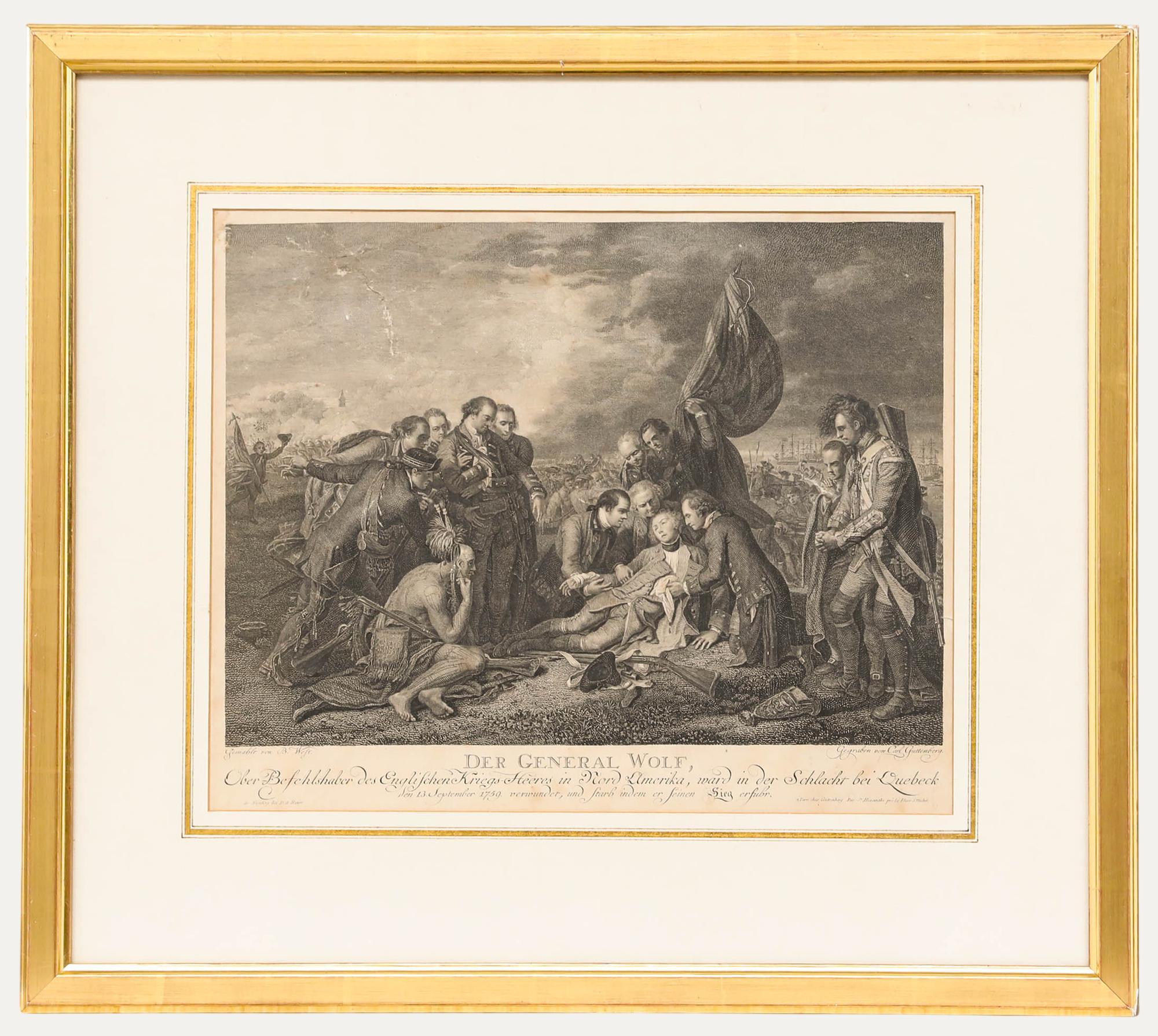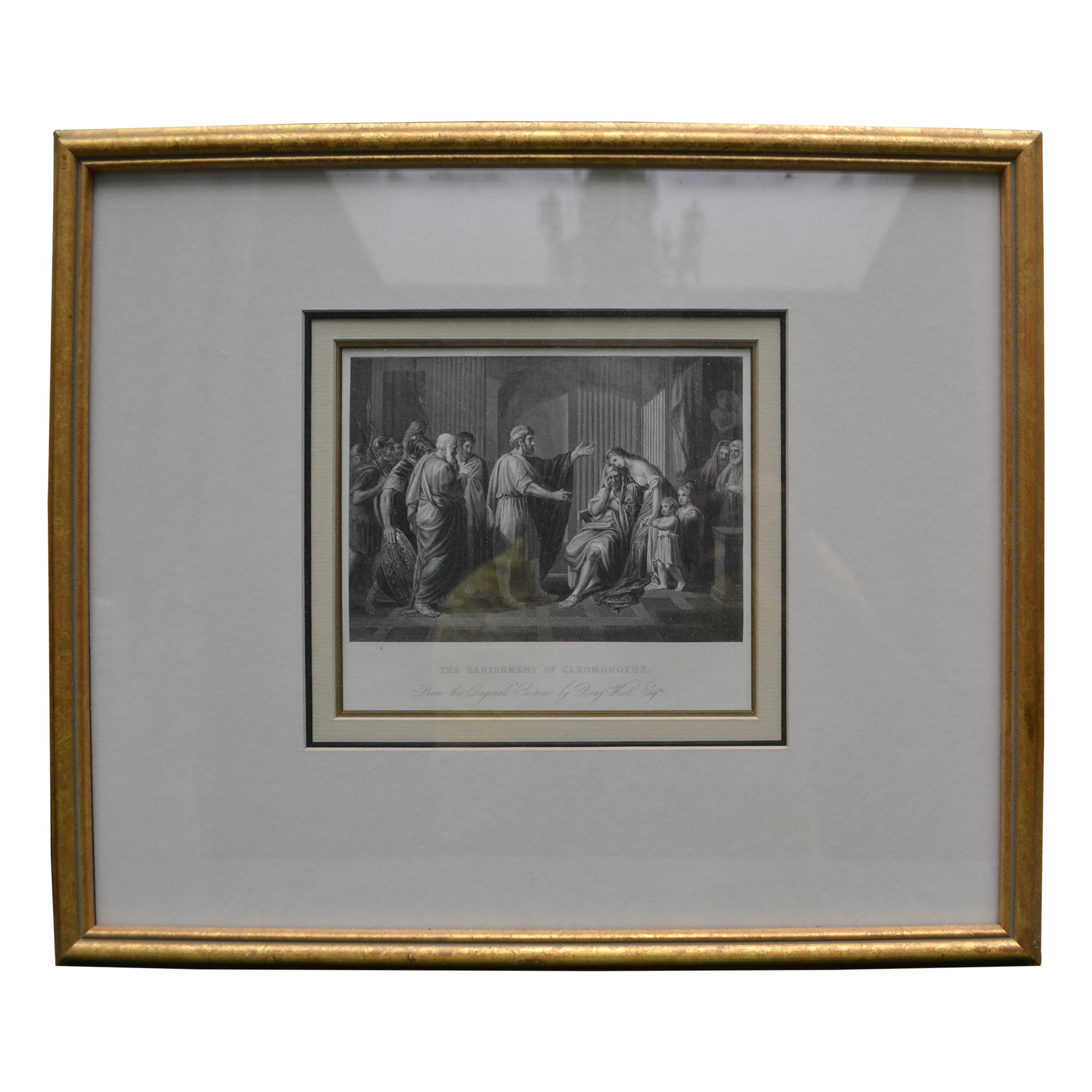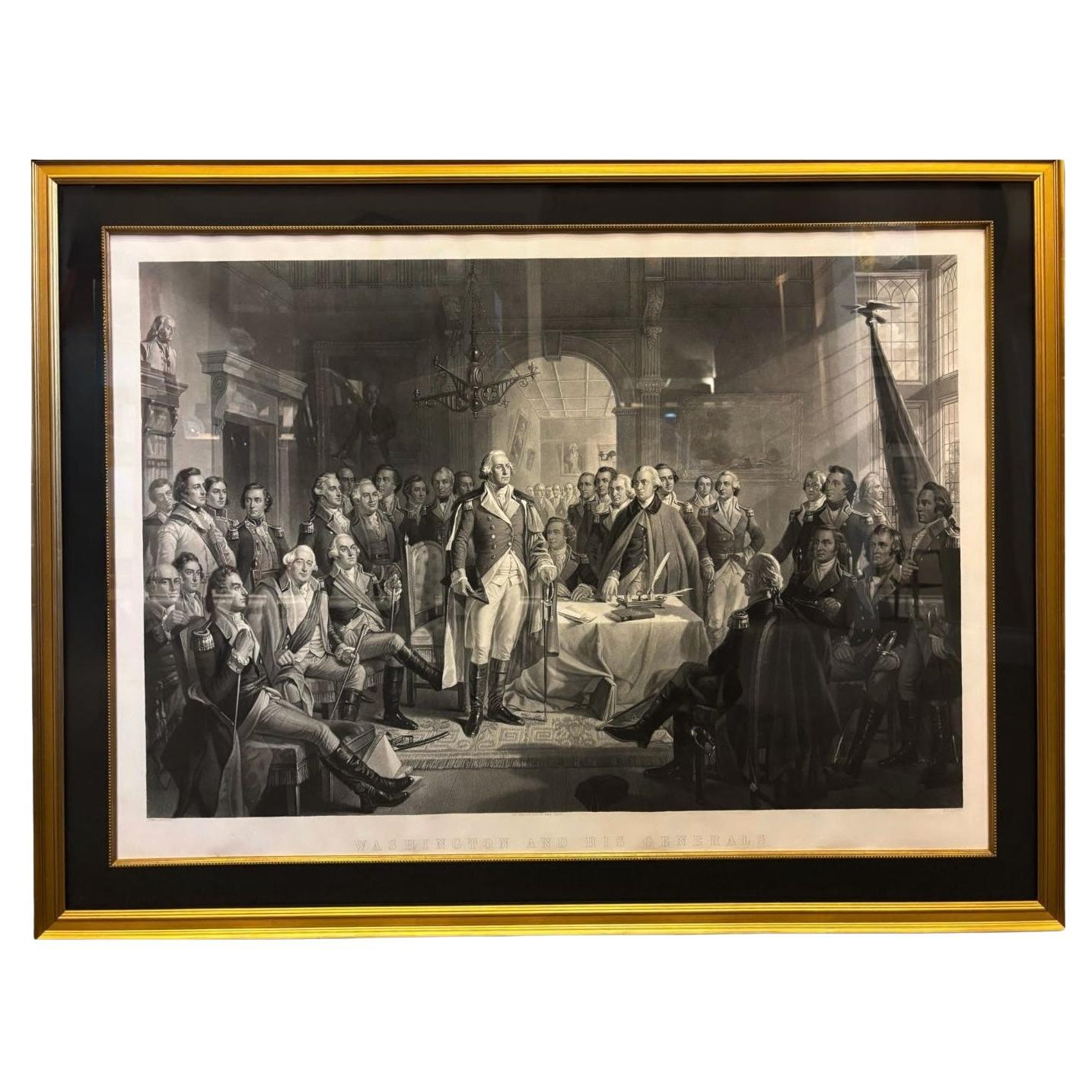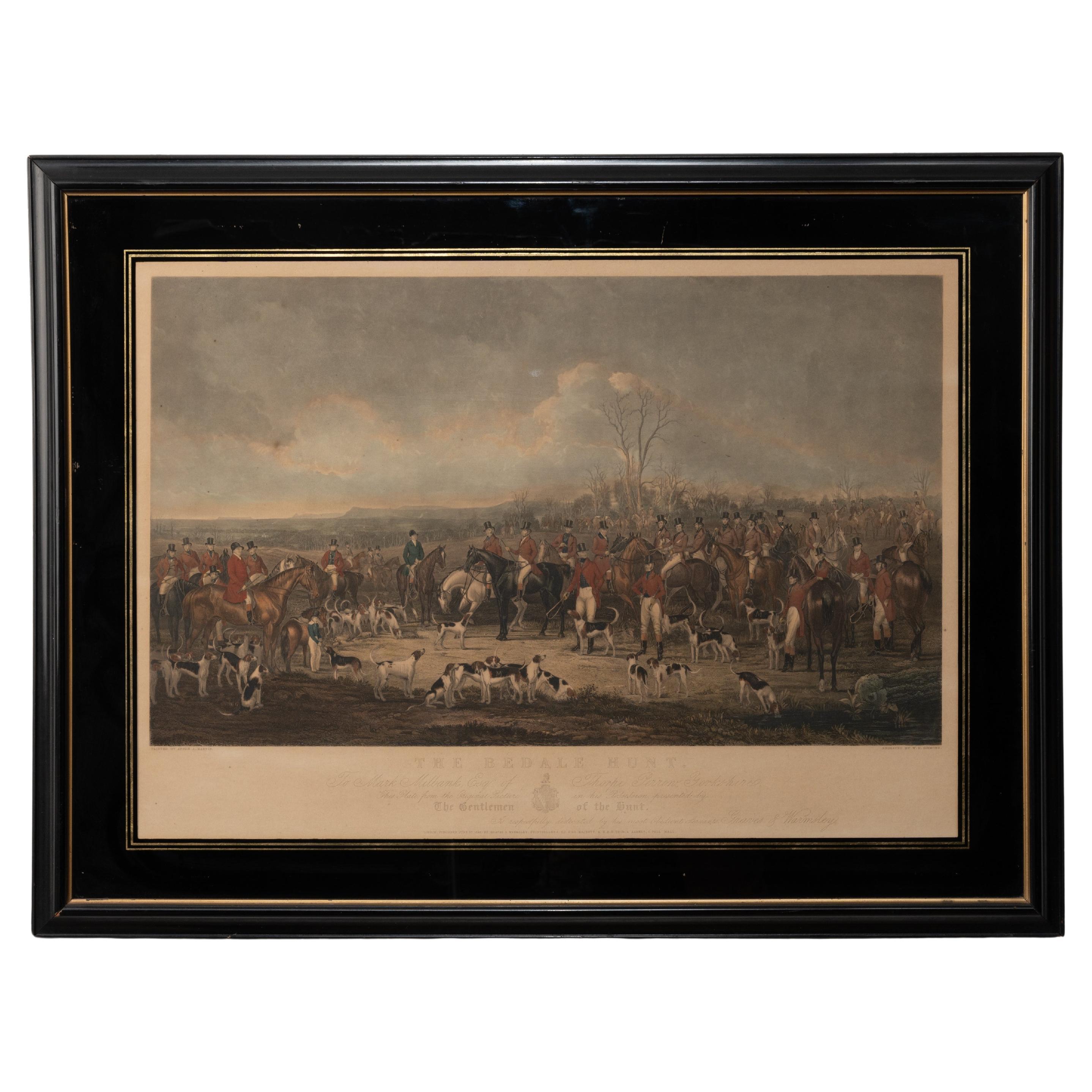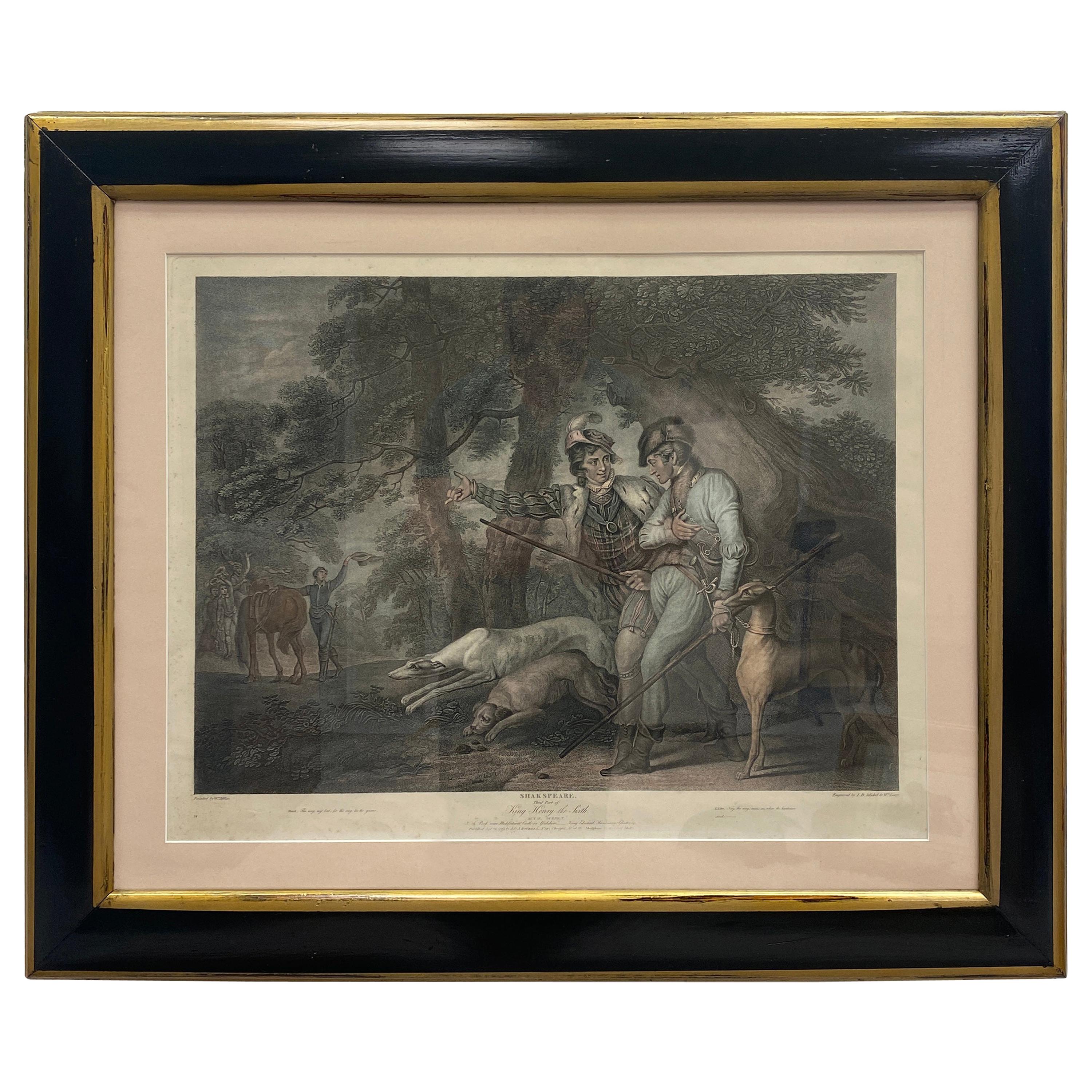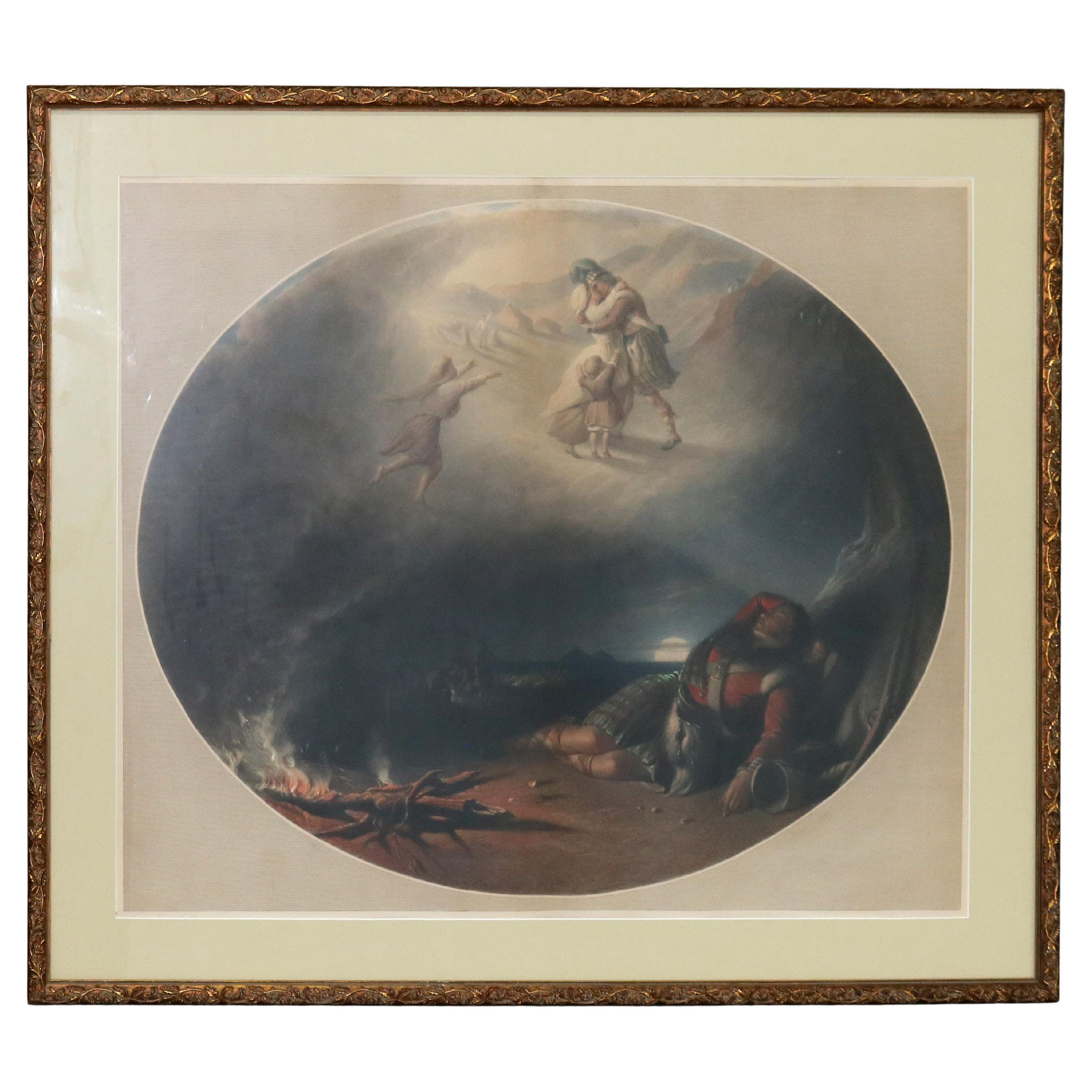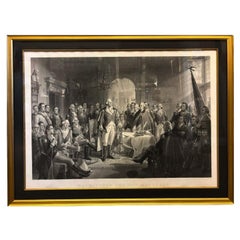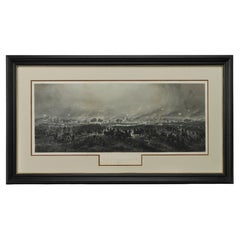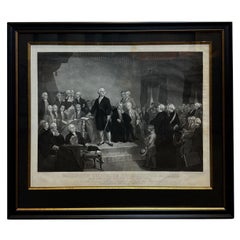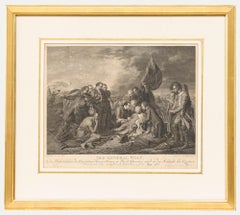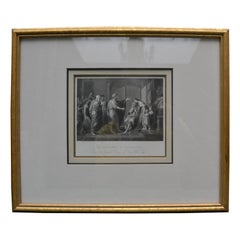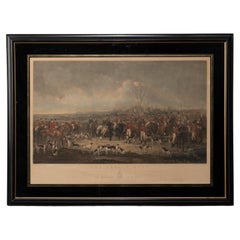Items Similar to "The Death of General Wolfe" Engraving by William Woollett, after Benjamin West
Want more images or videos?
Request additional images or videos from the seller
1 of 10
"The Death of General Wolfe" Engraving by William Woollett, after Benjamin West
$6,000
£4,530.65
€5,221.08
CA$8,468.55
A$9,336.38
CHF 4,884.49
MX$114,540.08
NOK 61,486.11
SEK 57,499.24
DKK 38,991.13
About the Item
Presented is one of the most important historical prints ever published, "The Death of General Wolfe," an engraving by William Woollett, after the painting of the same title by Benjamin West. The engraving was published in London by Woollett, Boydell, and Ryland, on January 1, 1776.
Benjamin West’s oil painting “The Death of General Wolfe” depicts the Battle of Quebec, a pivotal event in the Seven Years' War that decided the fate of France's colonies in North America and signaled Britain's ascendency in North America. The battle was fought between the British and French Armies on the Plains of Abraham, a plateau east of Quebec City, on September 13, 1759. The culmination of a three-month siege by the British, the battle lasted only about an hour. Commanded by Major-General James Wolfe, the British Army defeated the French forces under Louis-Joseph de Montcalm, yet General Wolfe was mortally wounded by several gunshots at the end of battle. To many, the victory in Quebec symbolized the inevitability of global British rule. In a period of heightened patriotism that followed the victorious battle, Wolfe became a national figure of veneration, honored by his King and countrymen, and widely celebrated in verse, songs, sermons, and the visual arts. The public had a seemingly insatiable appetite for representations of Wolfe and his heroic death and sacrifice for his country.
Benjamin West’s painting was created in 1771, at the height of the demand for images of Wolfe. The painting is not a literal account of Wolfe's death, but rather a poetic and symbolic rendering of the military victory. The composition centers on an injured and fallen Wolfe at center, his musket, cartridge box, and bayonet scattered on the ground in front of him. Captain Hervey Smythe holds Wolfe's right arm, while Dr. Thomas Hinde attempts to stem the bleeding. To the left, a messenger approaches with news that Quebec has fallen. Many of the other people surrounding Wolfe were not actually present when Wolfe died, but rather suggest the ethnic and geographical breadth of the new British Empire, like the Native American shown kneeling at right
With this painting, West also pointedly eschewed the long-established convention dictating that figures in historical paintings, even of contemporary subjects, be shown in Roman dress. Rather, he chose to portray Wolfe in his military uniform, insisting he wanted to depict the "facts of the transaction." This was considered very controversial at the time, so much so that King George III refused to purchase the painting since he believed that West's choice of clothing compromised the dignity of the image. Though not factually accurate, the painting was such a sensation that following its spectacular public debut at the Royal Academy in London, lines stretched out the door and five full-sized versions of it were commissioned by elite patrons.
This time period also coincided with a burgeoning market in prints, which created a new market of people who were not in a position to acquire expensive, original works of art, but could afford engravings, especially on a subscription model. Print publishers and engravers could anticipate selling many engravings done after popular paintings by famous artists. For this reason, West personally oversaw the production of an engraving of “The Death of General Wolfe,” choosing by one of the most accomplished printmakers of the time, William Woollett (1735-1785), to engrave his scene.
The print, a large engraving, was published in London by Messrs. Woollett, Boydell & Ryland, on January 1, 1776. One of the biggest commercial successes in British printmaking, the print helped make West's painting one of the most widely recognized images in England. It was also incredibly successful in Europe, garnering him 5,000-7,000 pounds in foreign sales. It was widely copied by engravers in France and Germany and was even pirated by other printmakers in England. The many iterations of West’s image found its way onto an untold number of objects and goods, including seals, ceramics and tableware, and fabrics. In this way, the engraving also helped to shape a burgeoning nationalism that celebrated England’s military power.
CONDITION:
Excellent condition. Engraving, on laid paper. Paper is very healthy. Strong impression. Small ink inscription to lower margin outside of plate mark. Title engraved in bottom center margin, “To the King's most excellent Majesty. This plate, The Death of General Wolfe, is with His gracious Permission humbly dedicated by his Majesty's most dutiful Subject & Servant, William Woolett. From the original Picture in the Collection of Lord Grosvenor.” “Published as the Act Directs, January 1, 1776… by Messrs. Woollett, Boydell, and Ryland, London” printed just below title, at left and right. “Painted by B. West, Historical Painter to His Majesty” engraved in the lower left margin. “Engraved by Wm. Woollet, Engraver to His Majesty” engraved in the lower right margin.
Engraving is artfully and archivally framed with black linen top mat, acid-free bottom mats, Coroplast backing, UV Plexiglas, and a custom-built wooden frame with gold fillet.
Framed dimensions: 26 3/4” H x 31 3/4” W x 1 1/2” W.
Accompanied by our company’s letter of authenticity.
- Creator:Benjamin West (Artist)
- Dimensions:Height: 26.75 in (67.95 cm)Width: 31.75 in (80.65 cm)Depth: 1.5 in (3.81 cm)
- Style:Georgian (In the Style Of)
- Materials and Techniques:Paper,Engraved
- Place of Origin:
- Period:1770-1779
- Date of Manufacture:1776
- Condition:Additions or alterations made to the original: Framed by Archival Art Custom Framing in Alexandria, VA, in January of 2025. Wear consistent with age and use. Minor fading.
- Seller Location:Colorado Springs, CO
- Reference Number:Seller: PR5151stDibs: LU909743539132
About the Seller
4.9
Vetted Professional Seller
Every seller passes strict standards for authenticity and reliability
Established in 2010
1stDibs seller since 2011
464 sales on 1stDibs
- ShippingRetrieving quote...Shipping from: Colorado Springs, CO
- Return Policy
Authenticity Guarantee
In the unlikely event there’s an issue with an item’s authenticity, contact us within 1 year for a full refund. DetailsMoney-Back Guarantee
If your item is not as described, is damaged in transit, or does not arrive, contact us within 7 days for a full refund. Details24-Hour Cancellation
You have a 24-hour grace period in which to reconsider your purchase, with no questions asked.Vetted Professional Sellers
Our world-class sellers must adhere to strict standards for service and quality, maintaining the integrity of our listings.Price-Match Guarantee
If you find that a seller listed the same item for a lower price elsewhere, we’ll match it.Trusted Global Delivery
Our best-in-class carrier network provides specialized shipping options worldwide, including custom delivery.More From This Seller
View All"Washington and His Generals" Engraving by A. H. Ritchie, circa 1870
By Alexander Hay Ritchie
Located in Colorado Springs, CO
This is a large, handsome engraving entitled Washington and His Generals by Alexander H. Ritchie, one of the best historical printmakers of the mid-nineteenth century. Ritchie is par...
Category
Antique 1870s American Federal Prints
Materials
Paper
"The British Surrendering their Arms to Gen. Washington..." after Renault, 1819
Located in Colorado Springs, CO
Presented is an engraving entitled “The British surrendering their arms to Gen. Washington after their defeat at Yorktown Virginia October 1781.” The dedication continues in the bottom margin, “To the defenders of American independence, this print is most respectfully inscribed by their fellow citizen, Jn. Fcis. Renault, assistant secretary to the Count de Grass, and engineer to the French Army, at the siege of York.” The engraving is after a painting by John Francis Renault, and engraved by Tanner, Vallance, Kearny & Co. and William Allen, in Philadelphia in January of 1819.
This historic print depicts the surrender of the British forces after the Battle of Yorktown. The print shows Lord Cornwallis offering his sword to the Duke de Lauzun, who defers the weapon to General Washington. British officers stand with Cornwallis on the right and French and American officers are shown at center and left. The immediate background is filled with an elaborate allegorical scene. Behind the British troops is a female representation of “Discord,” wearing a billowing robes and liberty cap and floating on storm clouds, as she sends lightning bolts to up-end the British people and a chariot below her. Behind the American and French officers, “Prosperity” stands next to an overflowing cornucopia, with “Justice”, an infant child with a paddle inscribed “American Constitution,” representing the helm of statehood. They crowd around a neoclassical monument with a giant urn...
Category
Antique 1810s American Federal Prints
Materials
Paper
1876 "Gettysburg, The Repulse of Longstreet's Assault." Engraving
Located in Colorado Springs, CO
Presented here is an 1876 engraving of John B. Bachelder and James Walker’s Gettysburg. The Repulse of Longstreet’s Assault. The engraved scene depicts the decisive battle on the final day of the Battle of Gettysburg. Researched by the photographer and topographer John B. Bachelder and painted by James Walker, the original painting was created in 1870. This detailed engraving was done by H. B. Hall Jr. and published by James Drummond Ball.
Otherwise called Pickett’s Charge, the battle occurred on July 3, 1863. Pickett’s corp commander, Lieutenant General James Longstreet was placed in charge of the attack despite his hesitations. Longstreet’s central role led to the title of the work, Repulse of Longstreet’s Assault. In an attempt to gain control of an important supply route, nine Confederate brigades charged across three-quarters of a mile of open ground against cannon fire to take Cemetery Ridge from the defending Union Army. Despite their overwhelming numbers, the Confederate forces were repelled with considerable casualties marking not only a decisive victory for the Union, but also the beginning of the slow defeat of Lee’s Army. The furthest the charging forces advanced before being repulsed would forever be known as the “High Water Mark of the Confederacy.” The Confederate army never recovered from the losses at Gettysburg and it effectively ended Lee’s campaign into Pennsylvania.
The engraving gives the perspective from the Union rear, one that encompasses most of the battlefield, from Big Round Top on the left to the northern reaches of Cemetery Ridge on the right. The Confederate lines at Seminary Ridge are in the far distance, partially obscured by bursting shells. The image centers on the main Confederate assault, in the vicinity of what today are known as "The Copse" and "The Bloody Angle." The composition has elemen...
Category
Antique 1870s American Prints
Materials
Paper
"Washington Delivering His Inaugural Address" Engraving by H. S. Sadd, 1860
Located in Colorado Springs, CO
Presented is a patriotic engraving titled “Washington Delivering His Inaugural Address. April 1789, in the old City Hall, New-York.” The print was engraved by Henry S. Sadd, after a ...
Category
Antique 1860s American Federal Prints
Materials
Paper
"On the March to the Sea" Print by Alexander Hay Ritchie, after F.O.C Darley
By Alexander Hay Ritchie
Located in Colorado Springs, CO
This color print of On The March to the Sea by Felix O.C. Darley, and engraved by A.H. Ritchie, is a stunning portrayal of William T. Sherman’s notorious Georgia Campaign. Originally...
Category
Antique 1860s American Prints
Materials
Paper
"Army of the Potomac" by John Bachelder, Civil War Era Lithograph, circa 1863
Located in Colorado Springs, CO
Fully-entitled: Army of the Potomac. The Wagon Trains of the Army of the Potomac en Route from Chickahominy to James River VA. During the Seven...
Category
Antique 19th Century American Prints
Materials
Paper
You May Also Like
Carl Gottlieb Guttenberg (1743-1792) - Engraving, The Death of General Wolf
Located in Corsham, GB
A fine engraving by Carl Gottlieb Guttenberg (1743-1792) after Benjamin West's (1738-1820) painting, 'The Death of General Wolfe'. The artwork commemorates the 1759 Battle of Quebec,...
Category
Early 18th Century Figurative Prints
Materials
Engraving
19th Century Engraving of Benjamin West 's the Banishment of Cleombrotus
By Benjamin West
Located in Vancouver, British Columbia
A 19th century steel plate engraving depicting the Banishment of Cleombrotus after the original by Benjamin West oil on canvas painting executed in 1768 and held at the Tate Gallery. The engraving is presented with beige matting and a gilded wooden frame.
Benjamin West showed this painting at the second exhibition of the newly formed Royal Academy. After several years in Italy, West had established himself in London as the leading painter of subjects from classical history...
Category
Antique Mid-19th Century English Neoclassical Revival Prints
Materials
Paper
$520 Sale Price
20% Off
The Bedale Hunt - W.H. Simmons Engraving, 1842
Located in Savannah, GA
William Henry Simmons
(British, 1811-1882)
Hand-tinted engraving after a painting by Anson Ambrose Martin.
sight: 29 ½ by 20 ½ inches
frame: 37 by 28 inches
Category
Antique 1840s British Victorian Prints
Materials
Glass, Wood, Paper
18th Century Framed Engraving of Scene from Shakespeares "King Henry VI"
Located in Nashville, TN
Wonderfully executed collaborative engraving from the end of the 18th century. Artists Jean Baptiste Michel (Paris) & Willim Leney (London) printed by "W.H. Miller" muted color palet...
Category
Antique Late 18th Century English George III Prints
Materials
Paper
$409 Sale Price
83% Off
English Print of “Soldier’s Dream of Home” by Frederick Goodall, Framed, 19thC
Located in Big Flats, NY
Antique English Print of “Soldier’s Dream of Home” by Frederick Goodall, Framed, 19thC
Measures - 31.5"H x 36.75"W x 1.25"D
A 19th-century antique Eng...
Category
Antique 19th Century Prints
Materials
Paper
$440 Sale Price
20% Off
Alexandre Joseph Desenne "the First Loves of Henri iv" Engraving, 19th Century
Located in Beuzevillette, FR
This splendid engraving is part of a series of 4 engravings. These différent engravings are entitled : « The archery », « the rendezvous at the fountain », « the infidelity » and fin...
Category
Antique Early 19th Century French Picture Frames
Materials
Paper
More Ways To Browse
Antique Death
Cartridge Box
Antique Porcelain Pug
Antique Pounce Pot
Antique Purple Glass Bottles
Antique Rococo Style Gold Table
Antique Ship Figurehead
Antique Silver Rattles
Antique Silver Tea Caddy Solid Silver
Antique Spirit Bottles
Antique Storage Chest Coffee Table
Antique Sugar Chest
Antique Swedish Fireplace
Antique Tantalus Decanter Set
Antique Tapestry Ottoman
Antique Terracotta Bottles
Antique Toy Dog
Antique Victorian Single Bed
